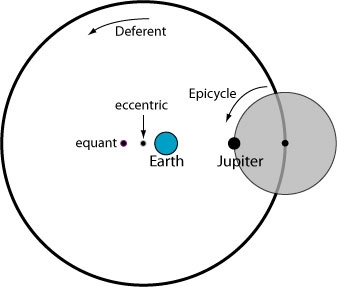What it shows: Long before the time of Copernicus, the Greek astronomer Claudius Ptolemy created a model of all the planets' observed celestial motions. The model involved combinations of perfect circles rotating with uniform speed. Ptolemy explained the apparent "looping motion" of the planets by placing the center of one rotating circle, called the epicycle, which carried the planet, on another rotating circle, called the deferent, so that together the motions of the two circles produced the observed looping motion of the planet. Moreover, the model accounted for the observation that each planet looks nearer to us (bigger and brighter) while in retrograde motion compared to when it's not, since it is closer to us when it is on the inside of the larger circle. The present demonstration shows how this model produces retrograde motion.

Ptolemy found that the angular rate at which the epicycle traveled was not constant unless he measured it from another point, which he called the equant. Midway between the equant and the Earth is the center of the deferent, called the eccentric. The angular rate at which the deferent moved around the eccentric was constant. It was the use of equants to decouple uniform motion from the center of the circular deferents that distinguished the Ptolemaic system.
How it works: The motions of the epicycle and deferent are locked together by a chain mechanism, which is hand-driven by a crank.
Setting it up: The epicycle machine lives on a dedicated cart and simply needs to be wheeled out of storage.